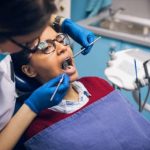A dental laser is a special laser used to counter oral surgery or dentistry. C. Kumar N. Patel made the first ever CO2 laser in 1964 and in the same following year the Nd:YAG laser was invented at Bell labs. The Food and Drug Administration (FDA) in the United States of America first approved the use of lasers in dentistry in 1994. Post-this development, the use of lasers on hard tissues like teeth or the bones of the Mandible i.e. jawbone was approved in 1996. Several variations of dental lasers are in use with different wavelengths, which means that they are better suited for different applications.
Dental lasers are used in the oral care field to treat multiple problems:
1. Teeth Whitening – a peroxide bleaching solution applied to tooth is ‘triggered’ by a laser energy, which fastens the whitening process.
2. Tooth Decay – to remove tooth decay and prepare the surrounding enamel for receipt of the filling.
3. Biopsy – lasers are used to remove a small piece of tissue called biopsy, which helps in inspecting cancer.
4. Gum Problems – laser technology helps in reshaping gums and removing bacteria
5. Remove Tissues – it helps remove overgrown tissues caused by certain medications.
6. Proper Movement – It helps in removing muscle attachments that restrict proper movement of the mouth.
How do Lasers work?
The goal of a dental laser surgery is to optimize photo biologic effects. The Photo thermal conversion of energy permits soft tissue incisions and excisions to be accomplished with accompanying precision. To understand this on a less scientific note, once a laser beam is produced it is aimed at the tissue to perform a precise task. In this task, four interactions occur once the energy reaches the interface, which are Absorption, Transmission, Scattering and Reflection.
“All lasers work by delivering energy in the form of light. When used for surgical procedures, the laser acts as a cutting instrument or vaporizer and when used for curing a filling, the laser helps in strengthening the bond between filling and tooth.” The dental lasers in common use today are Erbium, Nd:YAG, Diode and CO2. Each type of laser has special biological effects and procedures associated with them.
Advantages of using Laser Dentistry
• It is a more precise and advanced technology
• A more relaxing and pain less experience for the patient
• No more anesthesia injections or drill procedures are performed in the teeth
• Lasers can reduce symptoms and healing times associated with traditional therapies.
• Controls bleeding and swelling during surgery
• Helps to reduce the amount of bacteria in both gum tissues and tooth cavities
• It preserves a healthier tooth during cavity treatment.
Some Cons include
• Laser treatment is less pocket-friendly; its cost is much higher than a usual dental drill
• Lasers can’t be used on teeth with fillings already in place
• Laser is not a very reliable method as traditional drill may still be required during shape filling and bite adjustments due to irregular results
• The need to eliminate anesthesia is not completely over-ruled during laser treatment
To be sure of a Dentist’s proper laser training?
Asking your dentist questions about the extent of his/her laser education and training would be great place to start. Then make sure that your dentist has participated in educational practices and received training by the manufacturer. Popular dental schools, associations and the Academy of Laser Dentistry (ALD) offer dental laser education. The Academy of Laser Dentistry is the profession’s independent source for current dental laser education and credentialing.
The FDA 510(k) Clearance: a statement from American Dental Association
All dental lasers currently available in the U.S. market have a 510(k) clearance by the Food and Drug Administration. The team in-charge decides if the product meets the desired criteria for substantial equivalence. The review includes dental laser system specifications and safety mechanisms. Given the many factors that are appropriate to evaluate when using lasers, the council feels that the 510(k) process alone is not sufficient to demonstrate safety or efficacy. Properly designed preclinical and clinical studies are necessary to demonstrate safety and efficacy.
The council advises the dental practitioners to proceed with caution with the devices been cleared for market by the FDA 510(k) clearance. There are currently more than twenty cleared indications for use for dental lasers in the USA.
Conclusion
Laser use in dentistry is gaining popularity these days with advantages such as “pain less” experiences making laser dentistry friendly. “To gain something we have to sacrifice something else” – this statement is in contention with laser dentistry as it is a costly affair. Therefore, laser treatments carried out for oral care is more-or-less a luxury. Having said that, the treatment is only for those who could afford it, which is why the traditional methods of dentistry are in high demand.

